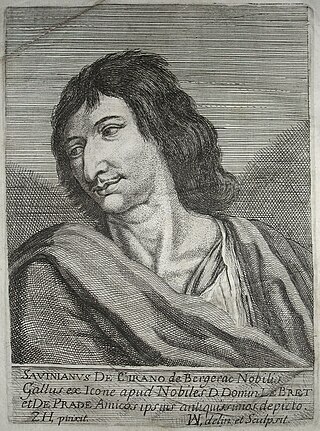
Savinien de Cyrano de Bergerac was a French novelist, playwright, epistolarian, and duelist.
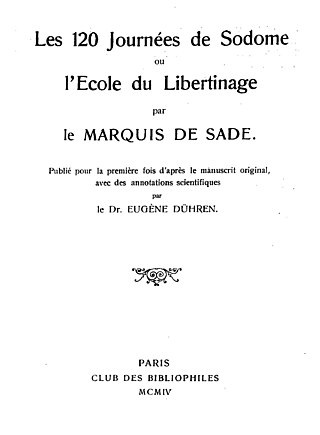
The 120 Days of Sodom, or the School of Libertinage is an unfinished novel by the French writer and nobleman Donatien Alphonse François, Marquis de Sade, written in 1785 and published in 1904 after its manuscript was rediscovered. It describes the activities of four wealthy libertine Frenchmen who spend four months seeking the ultimate sexual gratification through orgies, sealing themselves in an inaccessible castle in the heart of the Black Forest with 12 accomplices, 20 designated victims and 10 servants. Four aging prostitutes relate stories of their most memorable clients whose sexual practices involved 600 "passions" including coprophilia, necrophilia, bestiality, incest, rape, and child sexual abuse. The stories inspire the libertines to engage in acts of increasing violence leading to the torture and murder of their victims, most of whom are adolescents and young women.

Pierre Ambroise François Choderlos de Laclos was a French novelist, official, Freemason and army general, best known for writing the epistolary novel Les Liaisons dangereuses (1782).
A libertine is a person questioning and challenging most moral principles, such as responsibility or sexual restraints, and will often declare these traits as unnecessary or undesirable or evil. A libertine is especially someone who ignores or even spurns accepted morals and forms of behaviour observed by the larger society. The values and practices of libertines are known collectively as libertinism or libertinage and are described as an extreme form of hedonism or liberalism. Libertines put value on physical pleasures, meaning those experienced through the senses. As a philosophy, libertinism gained new-found adherents in the 17th, 18th, and 19th centuries, particularly in France and Great Britain. Notable among these were John Wilmot, 2nd Earl of Rochester, and the Marquis de Sade.

Justine, or The Misfortunes of Virtue is a 1791 novel by Donatien Alphonse François de Sade, better known as the Marquis de Sade. Justine is set just before the French Revolution in France and tells the story of a young girl who goes under the name of Thérèse. Her story is recounted to Madame de Lorsagne while defending herself for her crimes, en route to punishment and death. She explains the series of misfortunes that led to her present situation.

Philosophy in the Boudoir is a 1795 book by the Marquis de Sade written in the form of a dramatic dialogue. Set in a boudoir the two lead characters make the argument that the only moral system that reinforces the recent political revolution is libertinism, and that if the people of France fail to adopt the libertine philosophy, France will be destined to return to a monarchic state.
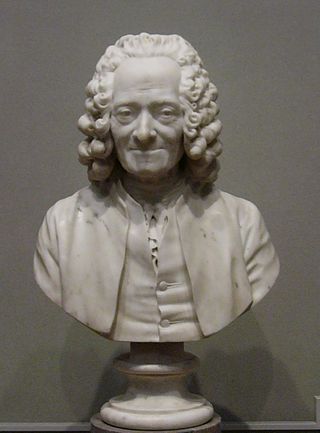
18th-century French literature is French literature written between 1715, the year of the death of King Louis XIV of France, and 1798, the year of the coup d'État of Bonaparte which brought the Consulate to power, concluded the French Revolution, and began the modern era of French history. This century of enormous economic, social, intellectual and political transformation produced two important literary and philosophical movements: during what became known as the Age of Enlightenment, the Philosophes questioned all existing institutions, including the church and state, and applied rationalism and scientific analysis to society; and a very different movement, which emerged in reaction to the first movement; the beginnings of Romanticism, which exalted the role of emotion in art and life.
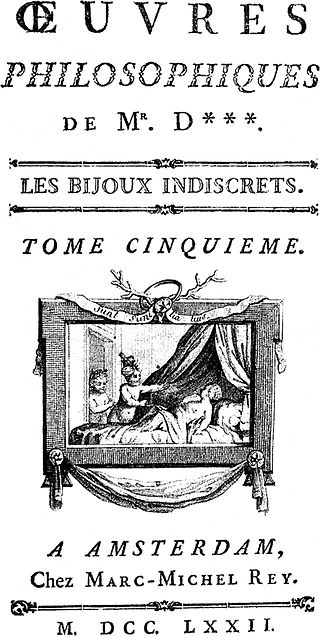
The Indiscreet Jewels is the first novel by Denis Diderot, published anonymously in 1748. It is an allegory that portrays Louis XV of France as Mangogul, Sultan of Congo, who owns a magic ring that makes women's vaginas ("jewels") talk. The character of Mirzoza represents Louis XV's mistress Madame de Pompadour. Diderot portrayed Pompadour in a flattering light in The Indiscreet Jewels, most likely to ensure her support for his Encyclopedie.
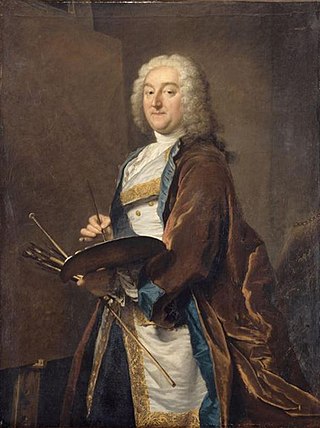
Jean-François de Troy was a French Rococo easel and fresco painter, draughtsman and tapestry designer. One of France's leading history painters in his time, he was equally successful with his decorative paintings, genre scenes and portraits. He was the inventor of the tableaux de modes, which attempted to provide a spirited portrayal of contemporary fashions, pastimes and manners.

Thérèse Philosophe is a 1748 French novel ascribed to Jean-Baptiste de Boyer, Marquis d'Argens, or, according to a minority opinion, Denis Diderot and others. It has been chiefly regarded as a pornographic novel, which accounts for its massive sales in 18th-century France. The novel represents a public conveyance for some ideas of the Philosophes.

The Sofa: A Moral Tale is a 1742 libertine novel by Claude Prosper Jolyot de Crébillon. It was first translated into English in the spring of 1742 in an edition published by John Nourse and Thomas Cooper. This translation has been attributed to Eliza Haywood and William Hatchett.

Maurice François Alfred Martin van Maële, better known by his pseudonym Martin van Maële, was a French illustrator of early 20th century literature, particularly erotic literature.

Les Égarements du cœur et de l'esprit ou Mémoires de M. de Meilcour is a novel by Crébillon fils, which appeared in three parts from 1736 to 1738. It is apparently unfinished, though critics differ on whether this was a deliberate decision of the author or whether he intended to finish it.
Jean-Baptiste Cyprien d'Huez was a French sculptor.
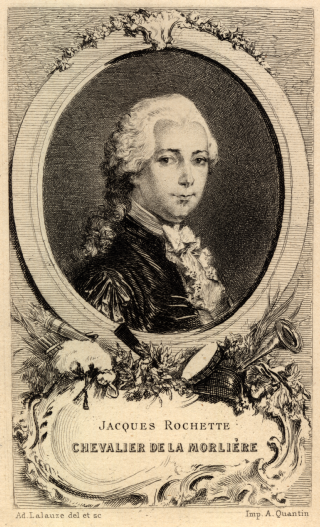
Charles-Jacques-Louis-Auguste Rochette de La Morlière, called "Le Chevalier", was an 18th-century French playwright.
Jean Galli de Bibiena was an 18th-century French-speaking writer, born in 1709 in Nancy and who may have died in 1779 in Italy. He was the son of Francesco Galli Bibiena, of the famous Galli da Bibiena family.
Under the French Ancien Régime, royal censorship was the task of censors appointed by the chancellor to judge the editorial legitimacy of a manuscript and to authorize its publication by an approval they signed.
Béatrice Didier is a French literary critic.












